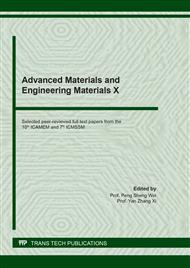[2]
C. X. Shi, Z. Y. Zhong, Forty years of superalloy R&D in China, Acta Metallurgica Sinica. 33 (1997) 1-8.
Google Scholar
[3]
C. X. Shi, Z. Y. Zhong, Development and innovation of superalloy in China, Acta Metallurgica Sinica. 46 (2010) 1281-1288.
DOI: 10.3724/sp.j.1037.2010.01281
Google Scholar
[4]
J. T. Guo, The current situation of application and development of superalloys in the fields of energy industry, Acta Metallurgica Sinica. 46 (2010) 513-527.
DOI: 10.3724/sp.j.1037.2009.00860
Google Scholar
[5]
F. C. Liu, X. Lin, W. W. Zhao, X. M. Zhao, J. Chen, W. D. Huang, Effect of solution treatment temperature on microstructures and properties of Laser Solid Forming GH4169 superalloy, Rare Metal Materials and Engineering. 39 (2010) 1519-1524.
DOI: 10.1016/s1875-5372(10)60122-1
Google Scholar
[6]
S. G. Tian, Y. C. Xue, Z. Zeng, Influence of solution temperature on compositions segregation and creep behavior of a single crystal nickel-based superalloy, Materials Science Forum. 747-748 (2013) 690-696.
DOI: 10.4028/www.scientific.net/msf.747-748.690
Google Scholar
[7]
Y. Zhou, Z. Zhang, Z. H. Zhao, Q. P. Zhong, Morphological evolution of γ' precipitates in a nickel-based superalloy during various solution treatments, Rare Metals. 31 (2012) 221-226.
DOI: 10.1007/s12598-012-0495-6
Google Scholar
[8]
X. M. Wang, Y. Zhou, Z. H. Zhao, Z. Zhang, Effects of solutioning on the dissolution and coarsening of γ' precipitates in a nickel-based superalloy, Journal of Materials Engineering and Performance. 24(2015) 1492-1504.
DOI: 10.1007/s11665-014-1368-y
Google Scholar
[9]
M. C. Pandey, Effect of solution treatment environment on the creep behaviour of a nickel base superalloy (NIMONIC 105), Scripta Materialia. 37 (1997) 1827-1830.
DOI: 10.1016/s1359-6462(97)00337-0
Google Scholar
[10]
E. X. Pu, W. Z. Zheng, Z. G. Song, K. Zhang, F. Yang, H. C. Lu, H. Dong, Evolution of microstructure and tensile properties during solution treatment of nickel-based UNS N10276 alloy, Materials Science & Engineering A. 705(2017) 335-347.
DOI: 10.1016/j.msea.2017.08.101
Google Scholar
[11]
R. Abbaschian, L. Abbaschian, R. E. Reedhill, Physical Metallurgy Principles, Forth Edition, Cengage Learning, (2010).
Google Scholar
[12]
J. Ye, American Nickel Base Superalloys, Science Press, Beijing, (1978).
Google Scholar


